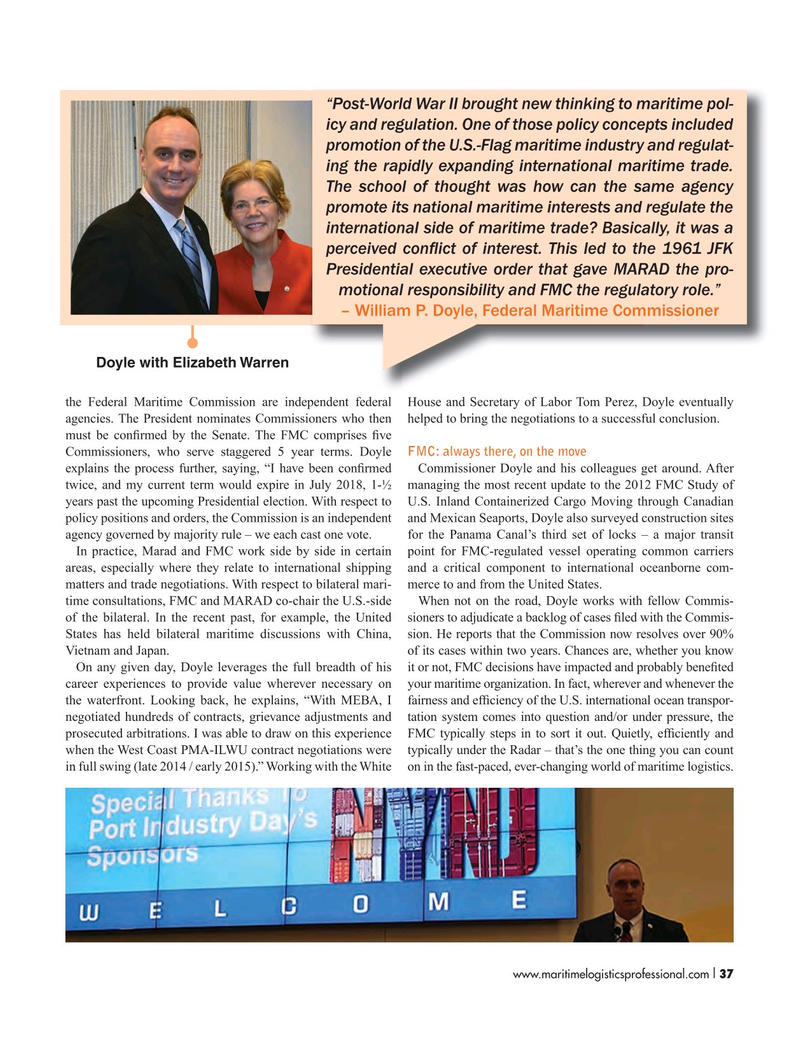
Page 37: of Maritime Logistics Professional Magazine (Q3 2016)
Shipbuilding, Repair & Maintenance
Read this page in Pdf, Flash or Html5 edition of Q3 2016 Maritime Logistics Professional Magazine
“Post-World War II brought new thinking to maritime pol- icy and regulation. One of those policy concepts included promotion of the U.S.-Flag maritime industry and regulat- ing the rapidly expanding international maritime trade.
The school of thought was how can the same agency promote its national maritime interests and regulate the international side of maritime trade? Basically, it was a perceived con? ict of interest. This led to the 1961 JFK
Presidential executive order that gave MARAD the pro- motional responsibility and FMC the regulatory role.” – William P. Doyle, Federal Maritime Commissioner
Doyle with Elizabeth Warren the Federal Maritime Commission are independent federal House and Secretary of Labor Tom Perez, Doyle eventually agencies. The President nominates Commissioners who then helped to bring the negotiations to a successful conclusion. must be con? rmed by the Senate. The FMC comprises ? ve
Commissioners, who serve staggered 5 year terms. Doyle FMC: always there, on the move explains the process further, saying, “I have been con? rmed Commissioner Doyle and his colleagues get around. After twice, and my current term would expire in July 2018, 1-½ managing the most recent update to the 2012 FMC Study of years past the upcoming Presidential election. With respect to U.S. Inland Containerized Cargo Moving through Canadian policy positions and orders, the Commission is an independent and Mexican Seaports, Doyle also surveyed construction sites agency governed by majority rule – we each cast one vote. for the Panama Canal’s third set of locks – a major transit
In practice, Marad and FMC work side by side in certain point for FMC-regulated vessel operating common carriers areas, especially where they relate to international shipping and a critical component to international oceanborne com- matters and trade negotiations. With respect to bilateral mari- merce to and from the United States.
time consultations, FMC and MARAD co-chair the U.S.-side When not on the road, Doyle works with fellow Commis- of the bilateral. In the recent past, for example, the United sioners to adjudicate a backlog of cases ? led with the Commis-
States has held bilateral maritime discussions with China, sion. He reports that the Commission now resolves over 90%
Vietnam and Japan. of its cases within two years. Chances are, whether you know
On any given day, Doyle leverages the full breadth of his it or not, FMC decisions have impacted and probably bene? ted career experiences to provide value wherever necessary on your maritime organization. In fact, wherever and whenever the the waterfront. Looking back, he explains, “With MEBA, I fairness and ef? ciency of the U.S. international ocean transpor- negotiated hundreds of contracts, grievance adjustments and tation system comes into question and/or under pressure, the prosecuted arbitrations. I was able to draw on this experience FMC typically steps in to sort it out. Quietly, ef? ciently and when the West Coast PMA-ILWU contract negotiations were typically under the Radar – that’s the one thing you can count in full swing (late 2014 / early 2015).” Working with the White on in the fast-paced, ever-changing world of maritime logistics.
I www.maritimelogisticsprofessional.com 37 34-49 Q3 MP2016.indd 37 8/17/2016 10:31:54 AM

 36
36

 38
38
